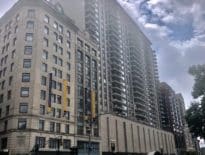
Rick Dimino
The Orange Line shutdown is making the benefits of a high-quality mass transit system obvious to everyone: businesses, students, residents, transit-dependent riders and even drivers who are not using public transportation. These will be even more apparent after the MBTA implements further service cuts to rapid transit and the bus network announced last month, and after Labor Day with the school year beginning, summer breaks ending and commuting patterns changing.
The absence of the Orange Line and reduced service levels on other lines and modes should make the heart grow fonder and produce a renewed commitment to supporting high-quality mass transit.
MBTA riders and residents of the commonwealth have come to accept the unfortunate cycle of promises followed by inaction and major accidents that lead to hollow calls to action. The only way to break out of this pattern is to change the safety culture at the MBTA and to respond effectively to findings released by independent experts, including the 2019 Safety Review Panel and forthcoming directives from the Federal Transit Administration.
After the 2019 Red Line derailment, the independent Safety Review Panel lead by former U.S. Secretary of Transportation Ray LaHood made recommendations to address safety deficiencies and improve the culture at the MBTA. The panel specifically recommended the T perform a financial analysis that would “identify the appropriate level of resources needed to ensure the safe delivery of service and support core business functions.” Three years later, it’s clear the MBTA never did this work.
T Needs to Account for Repair Bill
As of publication time, the FTA had not yet released the final report in its safety review of the T, but the document was expected to raise some additional, serious concerns. This document will inform the public about what work remains to be done and will require the MBTA take immediate action to improve the T’s safety.
The report should also motivate the MBTA to complete a full assessment of what it will cost to properly repair its infrastructure and what resources are available to complete the work. The last time the MBTA provided information on the state of good repair backlog was three and half years ago – they proclaimed it would require $10.1 billion to modernize the system.
Further inaction by the MBTA is not an option. The MBTA and the commonwealth, with help from the city of Boston as well as Massachusetts’ congressional leaders and high-level federal officials, must come together to collectively address the additional directives and develop corrective action plans that respond to the safety concerns and ensure the region’s mobility needs are met and the service is reliable.
This will require a comprehensive transportation finance plan that provides new revenue for operations, adequately funds capital repairs, and produces new incentives to encourage commuters to choose transit. Further, a new budget and fare philosophy is necessary to address the serious equity concerns for riders located in the urban core, as well as commuter rail riders who are forced to travel long distances because of our expensive real estate market. Means-tested fares and a rethinking of the prices for commuter rail should be implemented as part of a new budget plan for the MBTA.
Healey Gets Transit’s Value
There is some reason to believe real changes are ahead. Attorney General Maura Healey, currently the leading candidate for governor, released a very promising transportation platform that declared “the safety issues that have plagued our transportation system in recent years are unacceptable and will be the first challenge she will take on as governor.” She is promising to appoint a high-level safety chief to implement the FTA report, to look at ways to deliver infrastructure projects faster, cheaper and safer and to reform the governance and leadership structure at the MBTA. These are ideas that are justified and overdue.
But while the Orange Line shutdown is still in place, and before he leaves the corner office at the State House, there is another step that Gov. Charlie Baker can push the MBTA to take that will help riders: adding further enhanced commuter rail service out of North and South stations. At a minimum, the MBTA should be running trains every 20 minutes during the weekday and every 30 minutes during the evenings and weekends. Providing more frequent service on the commuter rail must be a key part of the MBTA’s longer-term strategy to mitigate the impacts of future rapid transit line shutdowns – and a permanent option to solve our congestion problems as the region expands.
The theoretical and real-life economic value of the MBTA is now clearer than ever. A Better City’s analysis found that the MBTA generates enormous value to the region, estimated at roughly $11.4 billion annually. Amid unprecedented safety, financing, equity and climate concerns, we need to lean in now to create a 21st century public transit system for our region.
The return on investment for a dollar spent on the T is significant, and a well-run T is critical to ensuring a strong near- and long-term economic future. The commonwealth, working in partnership with municipalities, must step up to implement the recommendations of the FTA report and to disclose the complete state of good repair backlog. And our leaders and the public must think boldly and creatively about way to finance and strengthen the management of the MBTA to create the modern transit system our region needs and deserves.
Rick Dimino is CEO of A Better City.






